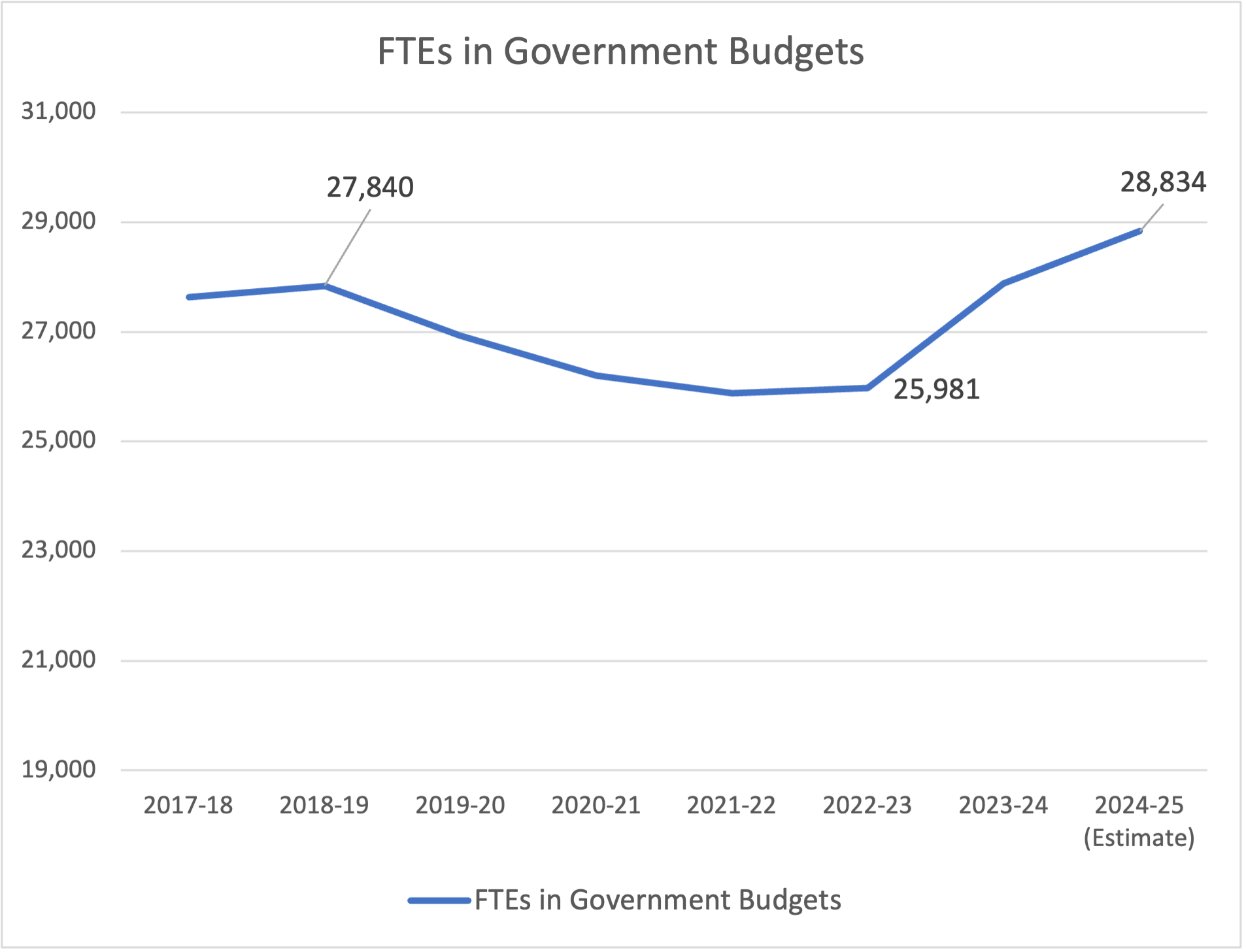Budget 2024 puts more pressure on public services and workers
Alberta Budget 2024: What AUPE members need to know
Mar 06, 2024
Even when there’s money, the attacks just keep coming.
That’s the message Premier Danielle Smith and the UCP government are sending with Budget 2024.
Public services in this province have faced years of cuts.
AUPE members know that only too well from their experiences in the workplace. The staffing shortage that plagued health care, education, government services and boards and agencies grew into a full-blown crisis during the COVID-19 pandemic.
Every sector, every workplace where AUPE has members report that there aren’t enough staff to do their jobs and that workloads are becoming unmanageable. Combine this with years of stagnant wages, and you’re left with workers who are burned out, stressed – and mad as hell.
Budget 2024 did nothing to address these problems, even though there was money.
The government reported a surplus of $6.4 billion last year, but not a penny of that was put into public services. A total of $4.4 billion was used to pay down debt and $2 billion went to the Alberta Heritage Fund.
Paying down debt and putting money into savings can be great – but not when public services are crumbling.
It’s like putting money aside to buy smoke detectors in a few years when your home is in flames in front of your eyes. We need to put out the fire first.
Looking to the year ahead, the government failed to increase spending to meet the population growth and inflation, which it predicted would be 6.2%. The bigger the population, the greater the demand for services. The higher the inflation, the more those services cost. Any increase in spending less than 6.2% is effectively a cut.
Between 2024 and 2026, Alberta population growth plus inflation as calculated by the Consumer Price Index (CPI) is expected to increase by 15.6%. By contrast, operational expenditures will increase by approximately half that at 8.5%.
This creates a shortfall of $4.1 billion. That’s what would be needed simply to keep pace with demand, but do nothing to address the problems created years of cuts.
The burden of this decision will be borne by front-line staff who will once again be called upon to do more, for less.

Health
To ensure the same quality of services seen last year, spending on health would have to increase by 6.2% to $26.7 billion in 2024-25. Unfortunately, operating expenses were set at $26.2 billion, up 4.4% from last year.
That means health care will be $500 million short on maintaining the status quo. The $1.1 billion increase that was included was almost entirely covered by an increase from the federal government of $997 million.
Remember, the status quo in health care is a system that is crumbling around us. The best Budget 2024 offers is an attempt to maintain that crumbling status, rather than try to fix it.
Wasted money
The government will continue with its plan to “restructure” Alberta Health Services (AHS), by breaking it into four different streams – Acute Care; Primary Care; Continuing Care; and Mental Health and Addiction.
This entirely unnecessary move has already cost $15 million and will cost another $70 million in 2024-25.
What else could have been done with that money?
In 2023, the $15 million could have paid for 170 Licensed Practical Nurses (LPNs) or 238 Health Care Aides (HCAs) for one year.
In 2024, the $70 million could have paid for 796 LPNs or 1,112 HCAs for one year.
Hiring more front-line health-care workers would do a lot more to improve care than a “restructuring.”
More wasted money
The UCP government spent $31.5 million to buy back laboratory services from DynaLife after its latest experiment with privatization failed. That could have paid for 358 LPNs or 501 HCAs for one year.
Meanwhile, the UCP government has cancelled plans to build a much-needed new hospital in south Edmonton.
According to a CBC report, the government has spent $69 million on that hospital project. That could have paid for 784 LPNs or 1,097 HCAs for one year.
Continuing care
Continuing care spending will increase by $11.7 million in 2024, a 0.97% increase from last year. This is a tiny increase when you consider the growing population of elderly people in Alberta.
This is largely because of the government’s focus on pushing home care instead of facility-based care. Home-care funding will increase by $86.7 million or 11.2%.
The Alberta government will sign a deal with the federal government that will allocate $70 million per year for long-term care initiatives, including hiring HCAs and other health workers, paying for wage increases or top-ups and for improvements to working conditions.
Another $70 million will go to home and community care initiatives and to enhance end-of-life care at home or in hospices.
Budget 2024 also includes an extra $654 million to provide grants to build and modernize continuing-care homes. In other words, this means giving taxpayer money to private operators of care homes to modernize their facilities – and to boost corporate profits.
Government services
Budget 2024 shows that even the UCP government knows it cannot run the province without workers.
After years of cuts, the number of full-time equivalents (FTEs) at the Government of Alberta has finally caught up with losses accrued during the UCP’s tenure, growing by 11% between the lowest point in 2022 and the projected 2024-25 budget.

Staffing levels have returned to the levels we saw in 2018, but there are now half a million more people demanding services. If staffing levels had kept pace with population growth from 2018 to 2024-25, the government would have to hire 2,901 more workers.
The recent FTE gains have not been equally spread across all ministries. Ministries with inadequate increases in FTEs include:
- Children’s and Family Services:
- 0 FTEs added in 2024-25 budget
- Only 11 FTEs promised last year; actual gains unclear due to restructuring.
- Seniors, Communities and Social Services:
- 0 FTEs added in 2024-25 budget
- 41 FTEs were promised last year, but FTEs only grew by 15 from 2023 to 2024.
- This leaves the 2024-25 budget estimating 26 fewer total FTEs than last year’s budget promised, which means a cut in available FTEs compared to what was planned for this time last year.
- Arts, Culture, and Status of Women:
- 0 FTEs in 2024-25 budget
- Indigenous Relations:
- 0 FTEs in 2024-25 budget.
- Municipal Affairs:
- 0 FTEs in 2024-25 budget.
The ministries with FTE gains often reflect the UCP government’s priority initiatives.
For example, the Ministry of Mental Health and Addiction is set to increase FTEs by 49% (52 FTEs), likely to accommodate the government’s restructuring of health care.
The Ministry of Energy and Minerals is budgeted to increase FTEs by 7% (32 FTEs) and Justice will increase staffing by almost 8% (245 FTEs).
FTEs in Forestry and Parks are set to increase by 11% (192 FTEs), more than half of which are earmarked for firefighting. However, the government is having problems recruiting and retaining firefighters.
Overall, the budget shows that UCP is increasing staffing only in specific areas that, in most cases, align with their own long-term priorities. Most social services that Albertans need continue to be left out.
Wildland firefighters
Despite a 17.4% increase of $52 million to the operating budget for Forestry and Parks to $351 million from last year, the ministry is still woefully underfunded.
The cost of wildfires and drought last year is estimated at $2.9 billion. This year, the government will again rely on its contingency fund, but that is pegged at $2 billion, despite legitimate fears that the current drought and coming hot temperatures will make this year as bad or worse.
The government announced that it will spend $151 over three years for wildfire preparedness, but this will be for equipment, rather than going towards boots on the ground.
There’s a recruitment-and-retention crisis for wildland firefighters in Alberta – and the budget does nothing to address this. More than 50% of Alberta firefighters don’t return for another year, with many taking jobs with the government of B.C. or Parks Canada, who pay more and provide better benefits and a pension.
Alberta’s wildland firefighting team is heading into the fire season with not enough firefighters and not enough experience to do their jobs safely.
Education
Advanced education
The UCP government continues to put more pressure on advanced education institutions.
While Budget 2024 provides a small measure of comfort for domestic students with a 2% cap on their tuition fees, it also says that universities and colleges are expected to cover more of their operating expenses this year and in future years.
Advanced Education operating expenses are projected to increase to $7.2 billion in 2024-25, from $6.5 billion last year, an increase of 1.7% above predicted population growth and inflation.
However, the requirement for universities and colleges to cover an increasing amount of their own funding, combined with the cap on tuition restricting revenue, may result in pressure being place on operating expenses, including the pay and working conditions of AUPE members.
The budget earmarks $63 million over three years for Olds College to renovate and expand student spaces in the W.J. Elliot Building. There is $16 million allocated in 2024-25 for SAIT’s John Ware Redevelopment in Calgary.
Schools
Spending on schools will increase by 4.8% in 2024, to $9.8 billion from $9.3 billion, below the predicted level of population growth and inflation of 6.2%.
The government says it will hire “more than 3,100 education staff, including teachers, educational assistants, bus drivers and school support staff.”
More than 80% of AUPE’s K-12 membership is made up of custodial and maintenance staff. The budget does not specify how many of the new hires will be in this field.
It is impossible to say what impact the new hires will have on schools and students because Alberta does not release student-teacher ratios unlike in most jurisdictions in Canada and the United States. This is despite the fact that these ratios are strongly correlated with student achievement.
According to the most recently available StatsCan data, Alberta is last among Canadian provinces in terms of per-pupil spending. In the 2020-21 school year, operational per-pupil expenditures are 15% higher in Canada overall than they are in Alberta.
The government clearly favours private schools more than public schools. Funding for private schools will increase by 13.5% over last year.
Boards and agencies
There is no indication in Budget 2024 that more people will be hired by boards and agencies this year to meet the demands of a growing population.
As always, that means existing workers will be expected to do more, but will not be given resources to accomplish this.
ATB Financial’s net income in 2023-24 significantly exceeded their forecasted revenue but, at least for AUPE members, this has not corresponded to improved staffing.
ATB predicted a revenue of $279 million in 2023-24, but Budget 2024-25 shows that actual revenue was 16% higher at $324 million.
Revenue is expected to continue rising at ATB, but the government continues to fail to divert any of that increased revenue to increase staffing.
Alberta Gaming, Liquor and Cannabis Commission (AGLC)’s net income in 2023-24 is reported to be relatively where expected, around $2.35 billion, and is expected to hold steady in 2024-25.
While the budget again fails to provide FTE numbers, AUPE membership at AGLC has made modest gains, recovering some of the losses seen in 2021.
Municipalities
Funding for municipalities in Alberta in Budget 2024 again fails to keep up with population growth and inflation.
It allocates $186 per Albertan to municipal infrastructure, compared to funding that reached $420 per capita in 2011. The budget fails to make even a small dent in the province’s $30-billion municipal infrastructure deficit.
The Rural Municipalities of Alberta (RMA) released a statement saying that the Local Government Fiscal Framework falls far short of historical levels, “and allocations for more targeted programs aimed at resource roads, bridges, and water infrastructure remain stagnant or were significantly reduced.”
Conclusion
In good years and in bad years, there’s never good news for workers, particularly those in the public sector.
Last year was a good year for Alberta government revenue, but none of the $6.4-billion surplus went to bolster public services or the workers who provide those services.
This year, things are apparently going to be tougher, so still no good news for those workers or for the Albertans who rely on the services they provide.
Do more with less is the message every time.
AUPE members in all sectors are saying they’ve had enough – enough of budgets that fail to keep up with growing demand, enough of wage freezes or small raises that fail to keep up with inflation, enough of staffing shortages and crushing workloads.
With more than 82,000 AUPE members entering into collective bargaining this year, it is important to remember that our collective strength as workers will ultimately determine the legitimate demands for higher wages and improved working conditions. So, even though the government is displaying signs scrawled with tired slogans of austerity and disregard for public services, workers may very well need to carry their own signs emblazoned with messages of determination and strength to fight for their demands and to protect the services they proudly provide.
News Category
- Member update

